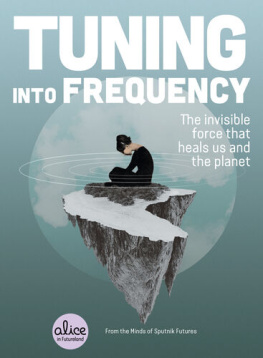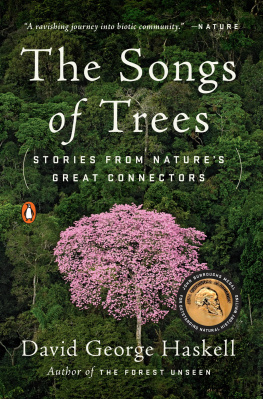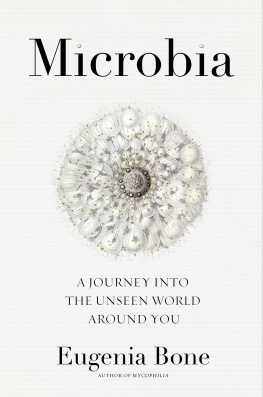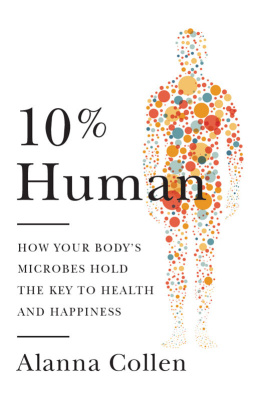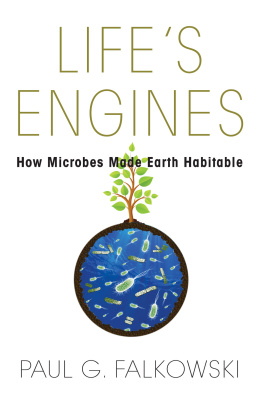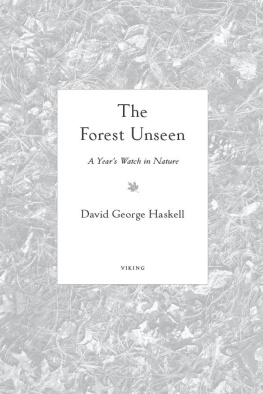Acknowledgments
I took on this book because I didnt know any better. When I explained what I was doing quite a few people wished me luck, kind of the way you might wish someone luck who is planning to represent themselves in court. Nonetheless, many very smart, generous folks were willing to help me wade through this daunting material.
I am very grateful to my professors at Columbia: Shahid Naeem, Dustin Rubenstein, Paul Olsen, Natalie Boelman, and Matthew Palmer. Early drafts of the book were read by Kyle Frischkorn, my lab teacher and a PhD candidate in microbiology at the Lamont-Doherty Earth Observatory, and Jonathan Rosenthal, who is in premed at NYU. They helped me get the basic science right, and I gratefully incorporated their corrections. Once the manuscript was done, the microbiologists Moselio Schaechter and Phil Strandwitz read it through, and their observations helped refine the text. Many thanks to Justin Kavanagh, whose insightful edits improved the book in countless ways. I cant thank my lay readers Ezra Herman and Paul Sadowski enough. They spent an inordinate amount of time and energy, considering every statement carefully, a task which I can only chalk up to love. Thanks to Pam Krauss for her insights. Shes tough, which is only one of the reasons why I admire her.
Three scientists were especially gracious about reading parts of the manuscript that pertain to their area of expertise. Timothy Crews, director of research and lead scientist at the Land Institute, read my chapters on soil and plants for accuracy. James White, mycologist and plant pathologist at Rutgers University, also read the chapters about soil and plants, and more. He was the godfather of this book, spending hours talking to me about microbes over beer and fish and chips. Congratulations on having Jimwhitea, a genus of Triassic fungi named after you, Jim! Kael Fischer, CEO at uBiota, read the chapters on the human microbiome. My first interview with Kael was so over my head that I had to take a nap afterward to recover. But as time went on Kael found my level and was consistently merciful and available and supportive. Thanks to astronomer Deno Stelter for reviewing my chapter on the origins of the universe.
I interviewed many scientists in the process of writing this book. Im thankful for the hours I was fortunate enough to spend in conversation with the brilliant Nicholas Money, mycologist at the University of Miami, Ohio. Many thanks to Kristine Nichols, chief scientist at the Rodale Institute; Russell Rodriguez and Regina Redman of Adaptive Symbiotic Technologies; Tom Volk, mycologist at the University of Wisconsin-La Crosse; and Mary Evelyn Tucker, of Yale University. A conversation with Mary Evelyn is like a flying dream: it soars. Thank you, Krista McGuire, biologist at Barnard College; microbiologist Scott Clark; Susan Holmes of Lane Community College in Eugene, Oregon; and Brendan Mormile, a PhD candidate at Texas A&M whose work on fungal endophyte/bacterial endophyte interactions in fescue grass is so elegant. Thanks to Britt Bunyard of Fungi Magazine, and Camille English, PhD candidate at Rutgers University, for letting me email you about a million times; and Douglas Eveleigh of Rutgers University, for the speed-date history lesson in microbiology.
Most of the scientists and academics I spoke to have or will have doctorates by the time you read this. I chose not to add their honorifics in the text but it should be noted they have devoted many years of study to their respective fields and through their ongoing research, publications, and lectures, they continue to add to our understanding of the unseen world.
I didnt talk exclusively with scientists but also farmers and agriculture professionals. I am especially grateful for the time and hospitality of Ron Heck; the Sweeney family; James Gillespie, Division of Soil Conservation & Water Quality, Iowa Department of Agriculture; David Ertl, Iowa Corn Promotion Board; Don Smith from Kiss the Ground; Lance Hansen of Jack Rabbit Hill Winery in Hotchkiss, Colorado; and the artist Andrew Cziraki.
I hope I have done your efforts justice. Forgive me for any errors. They are indisputably mine.
Many thanks to family and friends who shared quotes: Jasper Hartnett; Neni Panourgia; Tim Grabham; Paul Guilfoyle, former rust-eater; Sean Sullivan; Gary Lincoff, whose generosity of spirit and mind continues to inspire me; Carson Bone, ever insightful; Mo Bone, always hilarious; and Edward Giobbi, for his poops. Thank you to my many friends and colleagues who sent me articles, scientific papers, video clips, and images of microbes. Yes, Al Appleton, I read them all.
I have the annoying habit of working through ideas in dinner table conversation. You know who your friends are when they will sit through an hour of someone struggling to describe what a bacteriophage is and they still agree to hang out with you the following week. Among the most stalwart are Julie Rigby, Jody Guralnick, Michael Lipkin, Lisa Giobbi, Alex Neil, John Vennema, Diane and Gerard Koeppel, Cham Giobbi, Laine Valentino, Rachel Stroer from the Land Institute, James Oseland, Susan Murrmann, Nathalie Smith, John Zito, Jayne Morrell, Richard Zacks, Kristine Dahl, Louis Schwartzberg, and Stathis Gourgouris. Thanks for putting up with me Cornelia Cho, Sam Landes, Steve and Linda Rubick, Katherine McCarthy, Liz Lilien, Candy and Bob Penetta, Marley and Linda Hodgson, and Barb and Mike Heck. I am grateful for my sisters at Downtown Women for Change and my friends in the New York Mycological Society, and mushroom clubs and enthusiasts further afield, but especially David Campbell. Thank you Susan Goldhor and Aron Bernstein for your generosity and friendship, and special thanks to Susan, who read my manuscript and warned me about sounding whiney. Oh, and Michael Simmons. Sorry about the Starbucks thing.
On the bookmaking side, thanks to my agent, Angela Miller. I am usually low maintenance, but this time around I think I was a pretty exhausting client. Thank you, Angela, for being the ally I needed. Thank you to the Rodale team, Leah Miller, who took the leap of faith necessary to get this book started, Anna Cooperberg, Dervla Kelly, and Jennifer Levesque, the excellent Michelle Janowitz, Kathy Dvorsky, art director Amy King, Brianne Sperber, Marilyn Hauptly, Gail Gonzales, and the perfect, poised, and persistent Aly Mostel.
I am sure I have forgotten people who helped me over the years. For that oversight, please forgive me.
Most especially, I want to thank Kevin Bone. During the years it took to write this book, all the things I am in the habit of doing to help keep our lives running smoothly were chucked out the window. Kevin, Im sorry I bought those cookbooks and tried to make it look like I was supporting your suppressed passion for cooking when actually I had abandoned my part of our long-held division of labor. For all that, and more, including your excellent read of the manuscript, thank you. Every day I am grateful that my microbes are homogenized with yours.
Notes
Introduction
Much of the Introduction is first-person narrative combined from material found elsewhere in the book. Attributions for that material can be found in the Notes where they appear in the chapters. But for general biology, most of what I report I learned in lectures by Shahid Naeem, Dustin Rubenstein, Natalie Boelman, Paul Olsen (whose section I do not reference in the book), and Matthew Palmer during the two-semester course Environmental Biology I and II and in our textbook, Biology by Kenneth Mason et al. (New York: McGraw-Hill, 2014). Because the class didnt dwell on microbiology, I often returned to these two books by Lynn Margulis and Dorion Sagan: Microcosmos: Four Billion Years of Microbial Evolution (Berkeley: University of California Press, 1997) and Garden of Microbial Delights: A Practical Guide to the Subvisible World (Dubuque, IA: Kendall Hunt, 1993). Also very helpful was Moselio Schaechter, John L. Ingraham, and Frederick C. Neidhardt, Microbe (Washington, DC: ASM Press, 2006); Carl Zimmer, Microcosm: E. coli and the New Science of Life (New York: Vintage, 2009); Elio Schaechter (yes, same guy as Moselio), In the Company of Microbes: Ten Years of Small Things Considered (Washington, DC: ASM Press, 2016); Roberto Kolter and Stanley Maloy, eds., Microbes and Evolution: The World That Darwin Never Saw (Washington, DC: ASM Press, 2012); Nicholas P. Money, The Amoeba in the Room: Lives of the Microbes (Oxford, England: Oxford University Press, 2014); and Lewis Thomas, The Lives of a Cell: Notes of a Biology Watcher (New York: Viking, 1974), who proves that, yes, microbiology can be lyrical.
Next page


